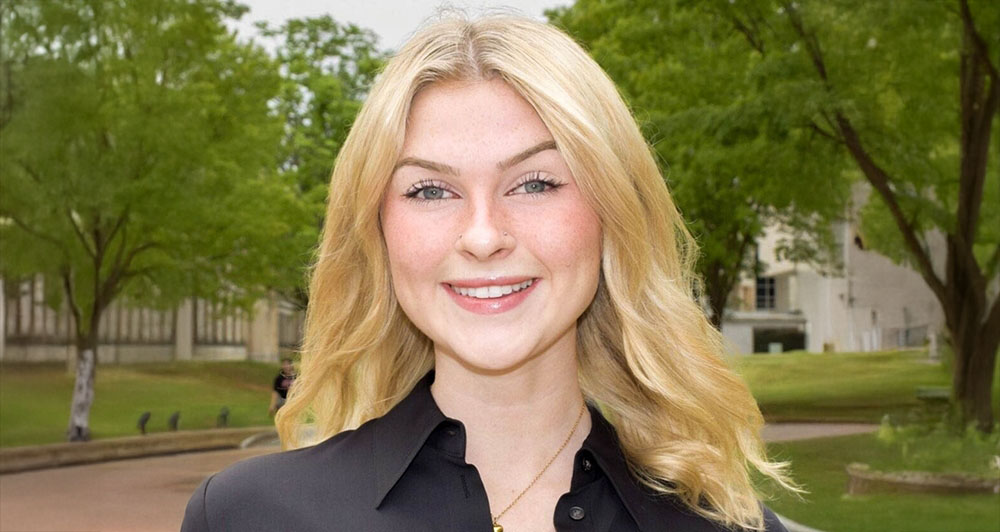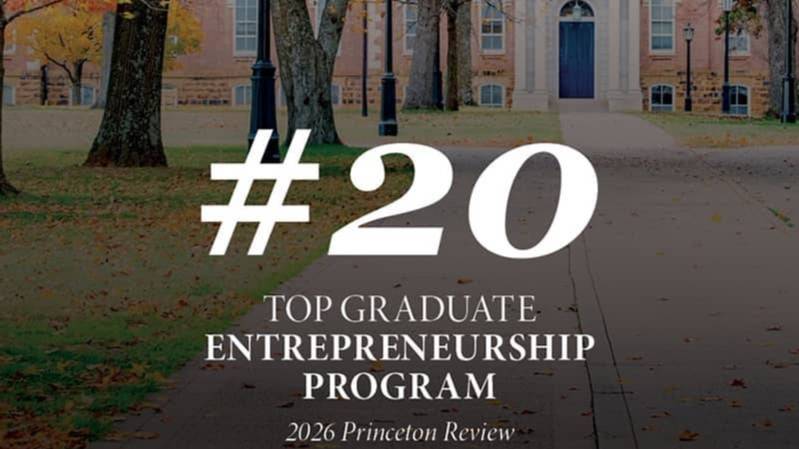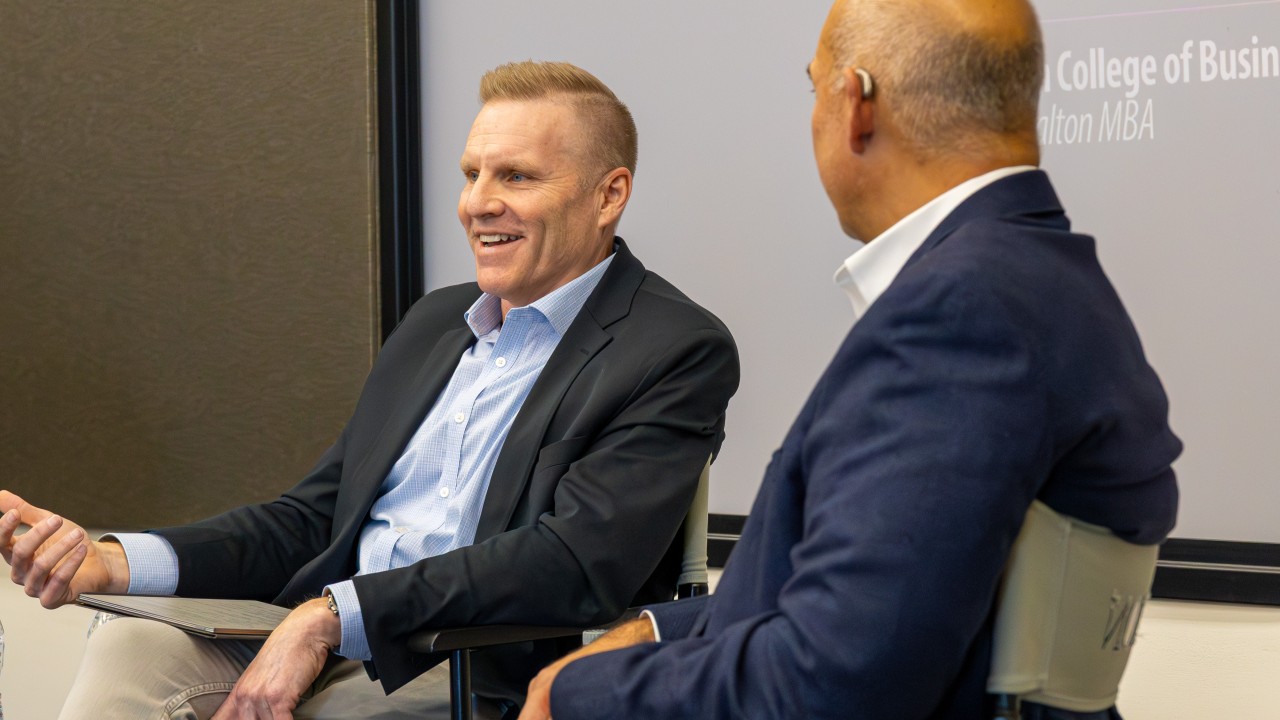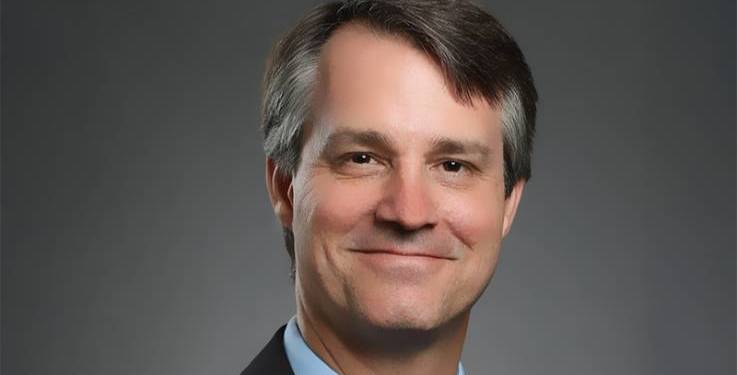
Matthew Waller, dean emeritus for the Sam M. Walton College of Business, and Adam Stoverink, executive director of the Walton MBA programs, are co-teaching Leadership & Organizational Behavior this fall to Walton full-time MBA and Walton Executive MBA students. The class explores Walmart as a semester-long case study, bringing leadership theories and principles to life through compelling examples and executive guest speakers.
This afternoon our MBA Leadership and Organizational Behavior class heard from Michael Ehret, Ph.D., Chief People Officer for Walmart International. His presentation focused on how leaders can understand motivation, increase satisfaction, and strengthen engagement through daily leadership practices.
Michael’s background provides a global view of leadership. Before joining Walmart, he spent 17 years at Johnson & Johnson, leading global talent management and succession planning. Today, he leads the People strategy for more than 550,000 associates across 18 countries. His work centers on associate growth, well-being, and the digital transformation of Walmart International’s workforce.
Understanding What Drives People
Michael explained how key motivation theories help leaders create environments where people thrive. He discussed Herzberg’s Two-Factor Theory, Self-Determination Theory, Expectancy Theory, and the Job Characteristics Model.
- Herzberg’s theory shows that “hygiene factors” such as pay and policy prevent dissatisfaction, while “motivators” such as recognition and growth drive satisfaction.
- Self-Determination Theory focuses on three needs that create long-term engagement: autonomy, competence, and relatedness.
- Expectancy Theory explains that motivation depends on believing that effort will lead to performance and that performance will produce valued outcomes.
- The Job Characteristics Model identifies meaningfulness, feedback, and autonomy as drivers of satisfaction and performance.
He reminded students that leaders are designers of motivation. By shaping the work environment, leaders help others find meaning and perform at their best.
Leadership as a Daily Practice
Michael emphasized that leadership is not limited to titles or formal authority. It happens through daily actions that shape culture and influence others. He referenced Drew Dudley’s “lollipop moment” to describe small acts of leadership that leave a lasting impression on others.
He encouraged students to look for opportunities to lead through listening, encouragement, gratitude, and recognition. Leadership often begins in moments that appear small but create meaningful change.
Energy Management and Sustainable Leadership
Michael presented the idea that effective leadership depends on energy management. He described four dimensions of energy that leaders must balance to remain effective and inspire others.
- Physical Energy supports stamina through good sleep, movement, and nutrition.
- Emotional Energy builds resilience and connection through empathy and gratitude.
- Mental Energy provides focus and clarity by maintaining concentration and taking renewal breaks.
- Purpose Energy fuels long-term motivation by linking actions to values and mission.
He explained that leaders must care for their own energy to stay present and engaged for others. Managing energy is not an act of self-interest. It allows leaders to sustain their focus and provide authentic support to their teams.
Preventing Burnout and Sustaining Engagement
Michael connected energy management to burnout prevention and employee engagement. He described Maslach’s Burnout Model, which includes exhaustion, cynicism, and reduced effectiveness, and linked it to Gallup’s engagement drivers such as clarity, recognition, and development.
When leaders help teams manage energy and focus on meaningful work, they build environments that promote long-term engagement and prevent burnout.
Leadership Commitments
At the end of his session, Michael invited students to act on what they learned. He proposed three personal commitments:
- Gratitude: Reach out to someone who has positively influenced you and thank them.
- Leadership Action: Identify one small behavior that can be practiced consistently to strengthen relationships.
- Energy Practice: Select one habit to improve physical, emotional, mental, or purpose energy.
These steps encourage leaders to grow through intentional, consistent action.
Final Thoughts
Michael’s presentation reminded students that leadership begins with awareness and daily behavior. Great leaders understand how to manage their own energy and create an atmosphere that allows others to succeed.
His message aligns with the spirit of the Walton College: leadership that is personal, practical, and focused on helping others reach their potential.
Motivation gives direction. Satisfaction sustains commitment. Engagement fuels performance. Great leaders strengthen all three by managing energy and creating meaningful work environments.
References
Deci, E. L., & Ryan, R. M. (1985). Intrinsic motivation and self-determination in human behavior. New York, NY: Plenum.
Hackman, J. R., & Oldham, G. R. (1976). Motivation through the design of work: Test of a theory. Organizational Behavior and Human Performance, 16(2), 250–279. https://doi.org/10.1016/0030-5073(76)90016-7
Herzberg, F. (1968). One more time: How do you motivate employees? Harvard Business Review, 46(1), 53–62.
Maslach, C., & Leiter, M. P. (1997). The truth about burnout: How organizations cause personal stress and what to do about it. San Francisco, CA: Jossey-Bass.
Vroom, V. H. (1964). Work and motivation. New York, NY: Wiley.
Dudley, D. (2010, September). Everyday leadership [Video]. TEDxToronto. https://www.ted.com/talks/drew_dudley_everyday_leadership
Gallup. (2017). State of the American workplace. Washington, DC: Gallup Press.




